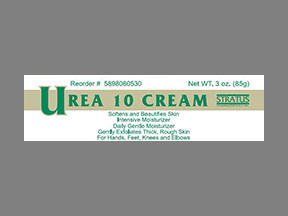
Urea Coupons & Savings Card – Discount Prices from $7.63
Generic for: Aqua care, Aquaphilic/carbamide, Gormel
My prescription
Edit
85GM of 10%, Urea (1 Tube)
Select pharmacy

Walgreens
$7.63
COUPON PRICE
Albertsons
$11.75
COUPON PRICE
Walmart
$16.12
COUPON PRICEUrea savings card
Show this card to your pharmacist
Walgreens
$7.63
BIN
ID
PCN
GRP
015995
LHEW016462
GDC
GDRX
Powered by
More prescriptions for psoriasis
Related keratolytics prescriptions
More prescriptions for psoriasis
Price history for Urea 10 Hydrating (brand) & Urea (generic)
1 Tube, 85GM of 10%
Average retail price for Urea 10 Hydrating
Average retail price for Urea
Average SaveHealth price for Urea
Our price history data is based on aggregated prescription data collected from participating pharmacies in America. Our prescription data updates daily to reflect the latest price changes. If you notice a missing data point, it means there wasn't sufficient data available to generate a monetary value for that date.
We analyzed Urea prices for (85GM of 10%, 1 Tube) over the last 12 months. The average retail price was $37.04, while the average price using the SaveHealth discount card was $8.00. That's a savings of approximately 78.40% when using our Urea coupon.
Compared to the generic version, Urea 10 Hydrating had an average price of $18.69 over the same time period. With the SaveHealth savings card, Urea is 57.20% cheaper on average than Urea 10 Hydrating.
*Retail prices are based on pharmacy claims data, and may not be accurate when we don't have enough claims.
Ureapro (Urea) dosage forms
Dosage Quantity Price from Per unit 85GM of 10% 1 Tube $9.78 $9.78 85GM of 10% 2 Tubes $17.57 $8.79 85GM of 10% 3 Tubes $25.35 $8.45 255GM of 45% 1 Tube $88.13 $88.13 255GM of 45% 2 Tubes $158.25 $79.13 255GM of 45% 3 Tubes $228.38 $76.13
| Dosage | Quantity | Price from | Per unit |
|---|---|---|---|
| 85GM of 10% | 1 Tube | $9.78 | $9.78 |
| 85GM of 10% | 2 Tubes | $17.57 | $8.79 |
| 85GM of 10% | 3 Tubes | $25.35 | $8.45 |
| 255GM of 45% | 1 Tube | $88.13 | $88.13 |
| 255GM of 45% | 2 Tubes | $158.25 | $79.13 |
| 255GM of 45% | 3 Tubes | $228.38 | $76.13 |
Urea Warnings
The following safety warnings are crucial for anyone using this medication to understand and follow. Please read carefully and consult your healthcare provider if you have any questions or concerns.
External Use Only: This medication is intended solely for application on the skin and nails. Avoid contact with the eyes, lips, and genital area. Ensure it is stored out of reach of children to prevent accidental exposure, as ingestion can lead to severe side effects.
Skin Reactions: Apply this medication strictly as prescribed by your healthcare provider or as indicated on the packaging. Discontinue use immediately and consult your healthcare provider if you experience redness, irritation, or a rash.
Foam Canister Safety: Be cautious with urea foam canisters, as they are pressurized. Do not puncture or expose them to high temperatures or open flames to prevent potential injury.
There are no listed contraindications for this medication.
Urea Side Effects
Common side effects:
- Stinging
- Burning
- Itching
- Irritation
Less common but important to monitor:
- Allergic reactions
Serious side effects:
- Severe allergic reactions
- Skin rash
- Hives
- Swelling of the face, lips, tongue, or throat
- Crusting or peeling of the treated skin
Urea Interactions
Urea, commonly used in topical treatments for dry or scaly skin conditions, can interact with certain medications and health conditions. While many interactions are minor, some require careful consideration.
Drug Interactions:
Pentoxifylline: Combining urea with pentoxifylline may enhance blood pressure-lowering effects, potentially leading to symptoms like dizziness or fainting. It's advisable to monitor for these effects and consult a healthcare provider if they occur.
Collagenase: Urea may moderately interact with collagenase, an enzyme used in wound care. This combination should be used cautiously and under medical supervision.
Vasopressin: A mild interaction exists between urea and vasopressin, a hormone used to treat certain conditions. While generally not significant, it's important to inform your doctor if you're using both.
Disease Interactions:
Fluid Overload: Urea, especially in forms that affect fluid balance, should be used cautiously in individuals with conditions like congestive heart failure or pulmonary edema, as it may exacerbate fluid retention.
Hyperosmolar Effects: Urea can increase blood tonicity. Those with liver disease, diabetes, or kidney dysfunction should use urea products carefully to avoid potential complications.
Always inform your healthcare provider about all medications and health conditions before starting urea treatments to ensure safety and effectiveness.
